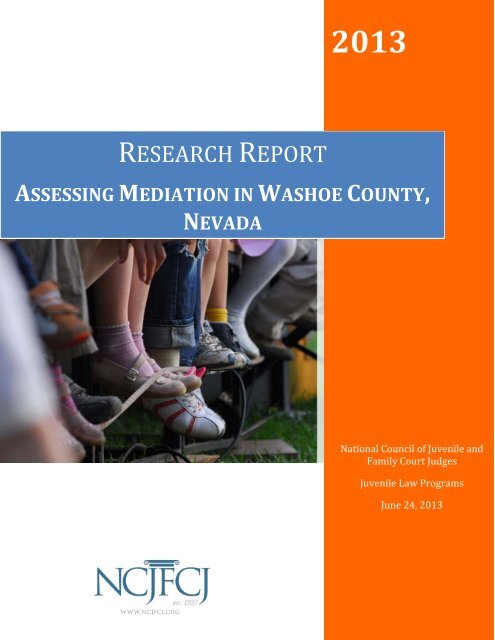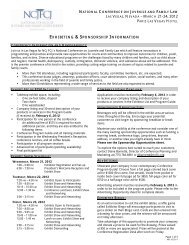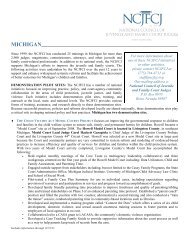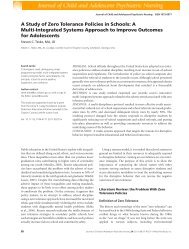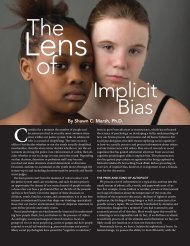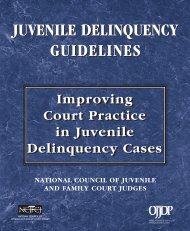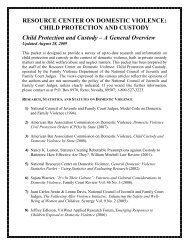here - National Council of Juvenile and Family Court Judges
here - National Council of Juvenile and Family Court Judges
here - National Council of Juvenile and Family Court Judges
- No tags were found...
You also want an ePaper? Increase the reach of your titles
YUMPU automatically turns print PDFs into web optimized ePapers that Google loves.
Table <strong>of</strong> ContentsIntroduction .................................................................................................................................................. 1Study Overview ............................................................................................................................................ 4Process Evaluation ....................................................................................................................................... 5Satisfaction Evaluation ............................................................................................................................... 14Outcome Evaluation ................................................................................................................................... 17Discussion & Recommendations ............................................................................................................... 17Conclusions ................................................................................................................................................. 171
Assessing Mediation in NevadaIntroductionWhen a child is removed from a home by child protective services (CPS), this child has entered the childdependency system w<strong>here</strong> an adversarial relationship between parents <strong>and</strong> CPS may develop. Distrust<strong>and</strong> confusion about the child dependency system can arise for parents <strong>and</strong> t<strong>here</strong> is need forcollaboration <strong>and</strong> resolution. Mediation is an option to avoid further litigation, which has been used fordecades to catalyze case processing <strong>and</strong> improve outcomes in juvenile dependency cases. 1alternative dispute resolution practice is a method that brings together all concerned parties tonegotiate <strong>and</strong> resolve issues with the assistance <strong>of</strong> a neutral third party (mediator). The main objective<strong>of</strong> mediation is to facilitate a discussion w<strong>here</strong> parties voluntarily resolve the issues that brought afamily into the dependency system <strong>and</strong> produce a written agreement, in lieu <strong>of</strong> a traumatic contestedhearing. 2 The mediation can include parents, CPS, attorneys, <strong>and</strong> all others that may be involved in thecase (e.g., guardian ad litem, <strong>Court</strong> Appointed Special Advocates (CASA), foster parents, other familymembers, etc.).The topics discussed depend largely on what issues are contested. If the mediation occurs preadjudication,topics may include petition allegations. Other contested issues that <strong>of</strong>ten arise <strong>and</strong> arediscussed at mediation may include: case planning, custody, visitation, shared parental responsibility,temporary <strong>and</strong> long‐term placement, foster care, relative placement, non‐relative placement, sheltercare, family dynamics, parent education, available services to families, family reunification, termination<strong>of</strong> parental rights, <strong>and</strong>/or adoption. 3ThisMediation should focus on the family’s strengths, create anenvironment w<strong>here</strong> parents are incorporated in decision making about their children, <strong>and</strong> prevent anyfurther abuse or neglect for the child. 2 T<strong>here</strong> are several potential benefits to mediation in childdependency cases which can include, but are not limited to: time savings, efficiency, parentengagement, <strong>and</strong> improved outcomes for children involved.1 Giovannucci, M., <strong>and</strong> Largent, K. (2009). A guide to effective child protection mediation: Lessons from 25years <strong>of</strong> practice. <strong>Family</strong> <strong>Court</strong> Review, 47, 38‐52.2 Superior <strong>Court</strong> <strong>of</strong> California, County <strong>of</strong> Alameda. Dependency Mediation. Retrieved from:http://www.alameda.courts.ca.gov/Resources/Documents/Dependency%20Mediation.pdf3 Eighth Judicial Circuit <strong>of</strong> Florida. Frequently Asked Questions: <strong>Juvenile</strong> Dependency. Retrieved from:http://circuit8.org/mediation/dependency‐mediation1
Time‐savings may occur for courts, attorneys, <strong>and</strong> social workers. This time‐savings can produce apotential lightened workload through the avoidance <strong>of</strong> further litigation <strong>and</strong> the trial preparation. 4Although mediation can take up to three hours (in Washoe County), if resolution occurs, this can savethe courts countless hours <strong>and</strong> provide more time for other cases to be processed. The mediationprocess is also advantageous because <strong>of</strong> parent engagement. A parent may come into mediation feelingangry, distrustful, <strong>and</strong> confused, but leave feeling empowered with a better underst<strong>and</strong>ing <strong>of</strong> the childwelfare agency <strong>and</strong> the dependency process. Mediation is conducted by an experienced pr<strong>of</strong>essional, ina confidential <strong>and</strong> respectful place. 2 Confidentiality can foster an environment w<strong>here</strong> parents feel theycan be honest because what they say will not be used against them in court. Because interested partiesat are the table, resolution (either full or partial) can be quite common <strong>and</strong> this can result in faster caseprogression, <strong>and</strong> ultimately may result in shorter times to permanency for children <strong>and</strong> families.Although t<strong>here</strong> are benefits to mediation, it does come with limitations. These include no‐show parents,disjointed buy‐in from stakeholders, <strong>and</strong> lack <strong>of</strong> facilitation skills on the part <strong>of</strong> mediators. With carefulevaluation <strong>of</strong> each court’s mediation process, many <strong>of</strong> these limitations can be mitigated with improvedoutcomes for the dependency system. For this reason, it is important to assess mediation programs,both in terms <strong>of</strong> the process <strong>of</strong> mediation, determining if it is being implemented as expected, <strong>and</strong> theoutcomes <strong>of</strong> evaluation in terms <strong>of</strong> how it may meet case goals.Program BackgroundIn August <strong>of</strong> 2011, the Second Judicial District <strong>of</strong> Nevada (Washoe County) established a juveniledependency mediation program. Modeled after a mediation program that ran in the district in the early2000s, the new program is funded by the <strong>Court</strong> Improvement Program (CIP), a U.S. Department <strong>of</strong>Health <strong>and</strong> Human Services program designed to support court initiatives related to improvingoutcomes for maltreated children involved in the court system. 5 To secure the funding, the lead juveniledependency judge in Washoe County worked with the state CIP Coordinator to identify mediation as agoal for the jurisdiction <strong>and</strong> apply for grant funds. Three mediators with years <strong>of</strong> experience mediating a4 Summers, A., Wood, S. <strong>and</strong> Russell, J. (2011) Assessing Efficiency <strong>and</strong> Workload Implications <strong>of</strong> the King CountyMediation Pilot. OJJDP Journal <strong>of</strong> <strong>Juvenile</strong> Justice, 1, 48‐59. Retrieved from:http://www.ncjfcj.org/sites/default/files/King%20County%20Mediation%20Pilot%20Article.pdf5 Crowley, M. (2012). Dependency Mediation. Nevada <strong>Family</strong> Law Review, 25, 12‐17.2
variety <strong>of</strong> issues were recruited for the program, <strong>and</strong> the program is administered by staff <strong>of</strong> the SecondJudicial District.In Washoe County, juvenile dependency cases are automatically ordered to mediation by the court ift<strong>here</strong> is a contested termination <strong>of</strong> parental rights (TPR) petition, contested permanency planninghearing, or other contested case issues. The date <strong>and</strong> time <strong>of</strong> the mediation session is set by the court,<strong>and</strong> formalized through a court order; participation by all parties to the case is m<strong>and</strong>atory. Three hoursare set aside for each mediation session.On the day <strong>of</strong> mediation, the mediator provides a mediation orientation for the parents <strong>and</strong> parties newto mediation. Recently, mediators have started staggering arrival times so that social workers <strong>and</strong>attorneys are not sitting idly in the waiting room. The mediators give each parent a brief overview <strong>of</strong> themediation process <strong>and</strong> parents then sign a confidentiality statement. Additionally, all parties sign aconfidentiality statement prior to the mediation.Mediators in Washoe County use a facilitative model <strong>of</strong> mediation, a style <strong>of</strong> mediation that emphasizesthe neutrality <strong>of</strong> the mediator. A facilitative mediator does not present his or her own views <strong>of</strong> the caseor <strong>of</strong> the agreement, <strong>and</strong> is instead focused on ensuring that all parties have an opportunity to be heard<strong>and</strong> that parties reach an agreement that meets everyone’s needs. 6At the conclusion <strong>of</strong> a mediation session, the mediators use a laptop to write the agreement while allparties are in the same room. The agreement is printed, signed by those who have authority to do so,<strong>and</strong> each party receives a copy. The agreement is then entered into the electronic case managementsystem <strong>and</strong> forwarded to the judge, who has to then sign the agreement <strong>and</strong> file a court order. Allparticipants are then asked complete a short survey regarding their perceptions <strong>of</strong> the mediation, theoutcome <strong>and</strong> how they were treated.6 Imperati, S.J. (1997). Mediator practice models: The intersection <strong>of</strong> ethics <strong>and</strong> stylistic practices in mediation. Willamette LawReview, 33, 703.3
Study OverviewThe Nevada Administrative Office <strong>of</strong> the <strong>Court</strong>s (AOC) contracted the <strong>National</strong> <strong>Council</strong> <strong>of</strong> <strong>Juvenile</strong> <strong>and</strong><strong>Family</strong> <strong>Court</strong> <strong>Judges</strong> (NCJFCJ) to conduct an assessment <strong>of</strong> the juvenile dependency mediation programin Washoe County. The assessment goals were threefold: to evaluate the implementation process <strong>of</strong> theprogram; to evaluate satisfaction with the program; <strong>and</strong> to assess what impact the mediation programmight have on outcomes for maltreated children. Along these lines, the current study seeks to answerthe following questions:Process Evaluation1. What were the challenges <strong>and</strong> successes with program implementation?2. What could have improved the program implementation process?3. Is the mediation program successfully engaging parents <strong>and</strong> stakeholders?4. Does mediation save court time/reduce workload?5. In what ways could the program be improved?Satisfaction Evaluation6. How are parents treated during mediation sessions?7. Do parents’ perceptions <strong>of</strong> treatment affect agreement rates?8. Do stakeholders <strong>and</strong> parents perceive that mediation is helpful?9. What did participants find most <strong>and</strong> least helpful about the mediation session?Outcome Evaluation10. Does mediation result in different outcomes for children <strong>and</strong> families?11. Does mediation result in timelier outcomes for children <strong>and</strong> families?12. Does mediation result in time savings in terms <strong>of</strong> vacated trials, hearing hours, <strong>and</strong> casecontinuances?For the process evaluation, an online survey was sent to stakeholders involved with the juveniledependency mediation program to learn more about successes <strong>and</strong> challenges with programimplementation, how the program is currently functioning, mediation utilization barriers, howmediation affects workload, <strong>and</strong> how the program can be improved in the future. Follow‐up interviewswith the mediators, program administrator <strong>and</strong> stakeholders were conducted to gain a fullunderst<strong>and</strong>ing <strong>of</strong> program implementation <strong>and</strong> functioning.4
As part <strong>of</strong> ongoing efforts to gauge program satisfaction, mediators give all mediation participants—parents <strong>and</strong> stakeholders—a survey after each mediation session. The survey asks participants whetheran agreement was reached, if participants had opportunities to voice their opinions <strong>and</strong> be a part <strong>of</strong>problem resolution, if participants felt like they had been ignored, treated with respect <strong>and</strong> trulylistened to, if the mediation session was conducted fairly, if they believed the mediated agreementwould work, <strong>and</strong> what they found the most <strong>and</strong> least helpful. A sample <strong>of</strong> the satisfaction surveys (n =44) was given to NCJFCJ researchers to explore differences in perceptions between parents <strong>and</strong>stakeholders <strong>and</strong> answer the research questions.In Washoe County, enough cases had been mediated to assess the program’s effect on case outcomes<strong>and</strong> timeliness <strong>of</strong> case processing. Using a st<strong>and</strong>ardized case file review instrument, researchers coded asample (n = 44) <strong>of</strong> cases that had been referred to mediation <strong>and</strong> a sample <strong>of</strong> cases (n = 47) that werenot mediated for. Because the majority <strong>of</strong> mediations occur at the TPR phase, the sample focused onlyon cases that had filed a petition to terminate parental rights.Process EvaluationTo assess the mediation process, researchers administered an online survey to system stakeholders <strong>and</strong>conducted follow‐up in‐depth interviews with key mediation participants (i.e., mediators, attorneys,etc.). The online survey was sent to child welfare stakeholders <strong>and</strong> mediators in February, 2013.Seventeen responded to the online survey. Fourteen respondents indicated their role (Table 1).Table 1. Role <strong>of</strong> RespondentsN %Administrator 1 7Attorney 6 43Social Work Supervisor 2 14Child Advocate 1 7Mediator 4 29Total 14 100Fourteen respondents indicated how many mediation sessions they attend per month on average. Half<strong>of</strong> the respondents (50%) said they attend one to two mediation sessions per month, while 29% attendthree to four. The remaining 21% indicated they never attend mediation sessions.5
ImplementationTo underst<strong>and</strong> how the mediation program was implemented, stakeholders involved in theimplementation process answered the following questions in the online survey: What were the barriers or challenges in implementation? What were the strengths in implementation? Were t<strong>here</strong> things that you believe could have been done to expedite the implementation orimprove the implementation process?Implementation BarriersIn Washoe County, program start up activities lasted about one month; the program was funded tobegin in July <strong>of</strong> 2011, <strong>and</strong> the first mediation occurred in August <strong>of</strong> 2011. The small delay was due toseveral reasons: extra time needed to update the program forms, procedures, <strong>and</strong> protocols; trainingmediators <strong>and</strong> stakeholders; <strong>and</strong> hiring a third mediator. Respondents said that barriers included a needfor more start up activities <strong>and</strong> training than anticipated, push back from some stakeholders becausethey felt mediation consumed time they did not have, lack <strong>of</strong> knowledge <strong>of</strong> how mediation could helpmove cases forward, <strong>and</strong> resistance to mediating rather than litigating. These challenges carried into thefirst few months <strong>of</strong> the mediation program; few cases were mediated until the court m<strong>and</strong>ated thatcertain types <strong>of</strong> cases be sent to mediation.Implementation StrengthsParticipants were also asked what worked well during project start up. Several respondents cited theinitial outreach to the stakeholders groups—child welfare agency, public defenders, district attorneys,children’s counsel, <strong>and</strong> CASA—in introducing the program <strong>and</strong> educating them on the mediation processas a crucial step in implementation success. Other elements important to program implementationsuccess were judicial leadership, mediators with enough experience to jump in <strong>and</strong> apply mediationprinciples to the child protection arena, <strong>and</strong> staff assistance <strong>and</strong> support.Improving Implementation ProcessParticipants were asked what could have been done to improve the implementation process. Responsesvaried from “introduce the program to stakeholders weeks in advance to implementation” to “t<strong>here</strong>6
needs to be someone in place who organizes <strong>and</strong> guides the project [implementation] from the start.”Additionally, several stakeholders said that it would have been better to start out the program withcourt ordered mediations rather than relying on people to volunteer.Program GoalWhen asked what the goal <strong>of</strong> the dependency mediation program is, several respondents said theprimary goal <strong>of</strong> the program is to engage in non‐adversarial dispute resolution to save time <strong>and</strong>eliminate the need for court. Respondents also said that the goal <strong>of</strong> the program is to give parties, <strong>and</strong>especially parents a voice in the dependency process; to help move cases forward to permanency; tohelp everyone look to the best interests <strong>of</strong> the children; <strong>and</strong> to get parties communicating <strong>and</strong> problemsolving.Program FunctioningSurvey participants 7 were asked to rate their level <strong>of</strong> agreement on several response items related toimplementation, participation, <strong>and</strong> effects <strong>of</strong> mediation. Table 2 presents the results for all responsesalong a five‐point scale, with 1 being “strongly disagree” <strong>and</strong> 5 being “strongly agree.” Higher numbers,t<strong>here</strong>fore indicate more agreement with the statement.Table 2. Average Response RatingsThe implementation <strong>of</strong> the mediation program was a success (n=13) 4.6All stakeholders who are invited attend mediation sessions (n=12) 4.2Parents, who are invited, attend mediation sessions (n=12) 3.9Mediation sessions are successful in reaching agreements (n=12) 4.7Parents at mediation sessions are engaged in the process (n=12) 4.7Mediation reduces the time to case resolution (n=11) 4.6All stakeholders at mediation sessions are prepared (n=13) 4.2All stakeholders at mediation sessions work toward reaching agreement (n=12) 4.3Parents at mediation sessions work toward reaching agreement (n=13) 4.2Mediation is a good alternative to court (n=13) 4.8All stakeholders get a voice at mediation sessions (n=12) 4.7Parents get a voice during mediation session (n=12) 5Age appropriate children are invited to attend mediations (n=13) 3.37 The n’s reflect the total number <strong>of</strong> participants who answered the question. While t<strong>here</strong> were 14 participantsoverall, not all completed the entire survey.7
As shown in the above table, the average response for most items ranged between somewhat agree <strong>and</strong>strongly agree. Some notable exceptions are that respondents indicated less agreement with “Parents,who are invited, attend mediation sessions” <strong>and</strong> “Age appropriate children are invited to attendmediations.” All survey participants who answered the question “Parents get a voice during mediationsessions” strongly agreed.Participants were also asked several open ended questions: What are the barriers to utilizing mediation for parents? What are the barriers to utilizing mediation for stakeholders? In moving forward with the mediation program, what are some ways in which the program couldbe improved?Utilization Barriers: ParentsIn terms <strong>of</strong> barriers for parents, one respondent noted that scheduling can be a barrier depending onparent’s employment <strong>and</strong>/or child care situation. Also, early morning sessions (i.e. 9am) have been abarrier for parents sometimes due to work schedules, lack <strong>of</strong> established daily routine, or other issues.The circumstances <strong>of</strong> parents’ lives can also act as barriers <strong>and</strong> prevent parents from attendingmediation sessions. Several participants said that parents are <strong>of</strong>ten unemployed, unsettled <strong>and</strong> have alack <strong>of</strong> resources, including transportation <strong>and</strong> telephone services. As a result, parent’s attorneys are<strong>of</strong>ten unable to reach the parents to remind them or tell them <strong>of</strong> the mediation appointment. Thesefactors contribute to the rate <strong>of</strong> no shows.Utilization Barriers: StakeholdersBarriers for stakeholders include time <strong>and</strong> competing dem<strong>and</strong>s. Attorneys, social workers, <strong>and</strong>mediators are very busy <strong>and</strong> scheduling all parties for 3‐hour blocks is a challenge. Another significantchallenge for stakeholders is buy‐in <strong>and</strong> satisfaction with the mediation process. One stakeholder notedthat mediation is a court‐ordered time investment that does not consistently result in an agreement.8
Program ImprovementAreas for improvement broadly included: providing parents with more information ahead <strong>of</strong> time on themediation process; more feedback to stakeholders regarding mediation; better trained mediators in thearea <strong>of</strong> dependency law; <strong>and</strong> more proactive mediation. One participant also said that more visiblecourt support <strong>of</strong> the program would be useful, while another suggested that t<strong>here</strong> should be some“focus on ways to have the mediations occur sooner in the case. So much time is lost [in terms <strong>of</strong> legaltimelines] before the parents come to agreement <strong>and</strong> get to work on their reunification tasks.”In terms <strong>of</strong> providing parents with more information ahead <strong>of</strong> time on mediation, one respondentsuggested providing an instruction sheet or appointment reminder at the hearing in which mediation isordered. The reminder could include the date, time, <strong>and</strong> place <strong>of</strong> the scheduled mediation, along withthe mediation department's contact information, <strong>and</strong> be provided to the parties along with theprogram's brochure.Several respondents noted that more feedback from the mediators <strong>and</strong> more contact with thestakeholders would be beneficial. This includes providing information <strong>and</strong> statistics regarding theagreement rate, <strong>and</strong> time <strong>and</strong> costs savings associated with mediation. This also includes follow uptraining with stakeholders to enhance engagement, <strong>and</strong> more frequent stakeholder meetings in order tobetter underst<strong>and</strong> their perception <strong>of</strong> mediation. One participant said that a feedback process thatallows all participants to feel comfortable in giving honest opinions would also be an improvement.Another participant indicated that training in the area <strong>of</strong> dependency law would be <strong>of</strong> great benefit tothe mediators. This opinion was seconded by another respondent who indicated that “if the mediatorswere better educated on the procedural status <strong>of</strong> any given case <strong>and</strong> what must really be mediated atany given session...much less time would be wasted.” In terms <strong>of</strong> mediation style, another participantsaid that the mediation sessions need to stick to the relevant issues being mediated <strong>and</strong> that, at times,the mediator needs to take better control over the session.WorkloadSurvey participants were asked how mediation affected their workload. The answers are reported inTable 3.9
Table 3. Mediation <strong>and</strong> WorkloadMediation reduces my workload (n=11) 3.64Mediation requires the same amount <strong>of</strong> time as going to court (n=12) 2.36Mediation adds to my workload (n=12) 2.82As shown above, the average answer from participants regarding reduction <strong>of</strong> workload was between“neither agree nor disagree” <strong>and</strong> “somewhat agree.” Conversely, the average answer regardingincreases to workload was between “neither agree nor disagree” <strong>and</strong> “somewhat disagree.” T<strong>here</strong>spondents “somewhat disagreed” that mediation requires the same amount <strong>of</strong> time as going to court.Additional Comments regarding workload included:When all the parties come to the table in good faith with a collaborative attitude <strong>and</strong> areprepared, mediation <strong>of</strong>ten results in an agreement, which reduces the stakeholders' workload.Mediation actually increases my workload because I typically am not required to testify in trials.Mediation requires me to do a lot <strong>of</strong> preparation <strong>and</strong> meet with the workers <strong>and</strong> attorney inadvance <strong>of</strong> the session, <strong>and</strong> then the session itself is set for 3 hours. In my opinion t<strong>here</strong> is a lot<strong>of</strong> time wasting that occurs in the 3 hours. It doesn't feel like t<strong>here</strong> is ever a sense <strong>of</strong> urgency toget the work <strong>of</strong> the meeting completed.Follow Up InterviewsIn‐depth interviews were conducted with eight mediators <strong>and</strong> juvenile dependency stakeholders to geta better sense <strong>of</strong> how the program was implemented, how it is currently working, <strong>and</strong> any areas forimprovement. Interview participants were asked specifically about the barriers <strong>and</strong> successes related toprogram implementation, challenges, improvement areas, parent <strong>and</strong> stakeholder engagement, <strong>and</strong>benefits <strong>of</strong> the program. (Questions are listed below in blue.) The themes that arose from the interviewswere similar to the responses found in the online survey <strong>and</strong> although t<strong>here</strong> were several differentquestions asked, the same issues seemed to appear in different questions.What did you see as barriers to implementing the mediation program?Buy‐in from stakeholders. Most interview participants noted that after attending severalmediations <strong>and</strong> seeing the results, opinions began to shift about mediation. It was no longer10
seen as “just one more thing to do” but is now seen, by most, as a time savings investment byultimately preventing days‐long trials.Voluntary mediations. In the beginning <strong>of</strong> project implementation, mediations were voluntary;however they are now court‐ordered. When the mediations were voluntary, t<strong>here</strong> was littlebuy‐in from stakeholders who already felt over‐worked, so this made success difficult to attain.Parent attendance issues. Although mediation is now court‐ordered in dependency cases, t<strong>here</strong>is no enforcement when parents do not show up. Some respondents felt t<strong>here</strong> should be someconsequences for not attending mediation.Fragmented framework. Some participants stated that the inadequate framework in thebeginning was a barrier, because this created confusion about the process <strong>and</strong> expectations.Many people proceeded <strong>and</strong> felt they couldn’t wait for others to “get on board”; this may havecreated discomfort for some who may have been new to the process.What did you see as successes to implementing the mediation program?Good communication. It was noted that communication among mediators <strong>and</strong> the court wasgood. This helped to smooth out the referral process.Outreach <strong>and</strong> passion. Initial outreach by mediators to educate stakeholders about mediationwas successful. Many <strong>of</strong> the mediators are very passionate about mediation <strong>and</strong> know howsuccessful it can be.Transition to court‐ordered mediation. As stated above, when the program was initiallyimplemented the mediation was voluntary but that has since moved from voluntary to courtordered mediations.What are the biggest challenges to reaching an agreement?Adversarial propensity. Some in the mediation process still have the desire to litigate rather thanreach an agreement outside <strong>of</strong> court. T<strong>here</strong> can be unwillingness to compromise <strong>and</strong> someparticipants are coming into mediation very positioned.11
<strong>Juvenile</strong> dependency timelines (Adotion <strong>and</strong> Safe Families Act <strong>of</strong> 1997). Some parents may stillbe trying to reunify, even though it may be a termination case. This may leave parents feelinglike they are not part <strong>of</strong> the process <strong>and</strong> parties come to mediation with different agendas.No shows. This was an issue that appeared many times throughout the interviews <strong>and</strong> t<strong>here</strong> wasa level <strong>of</strong> frustration with this. Some participants felt that t<strong>here</strong> may be a communication issue,with some parents being transient <strong>and</strong> difficult to get a hold <strong>of</strong>, <strong>and</strong> others felt that parent’sattorneys did not clearly communicate the mediation date to them.New to the process. Unclear underst<strong>and</strong>ing <strong>of</strong> juvenile dependency on part <strong>of</strong> mediators wasdiscussed as an issue, because they lack a clear underst<strong>and</strong>ing <strong>of</strong> the law. Also, new or privateattorneys can create a challenge because they may be new to the dependency system <strong>and</strong> themediation process <strong>and</strong> are unclear as to the goals <strong>of</strong> mediation.Parents. Parents themselves can sometimes pose the biggest challenge in mediation because forthem so much is at stake <strong>and</strong> <strong>of</strong>ten times they may have “dug their heals in” before they reachmediation.What do you see as areas <strong>of</strong> the program that need improvement?Education about the benefits <strong>of</strong> the process. Several stakeholders acknowledged that moreinformation about the program’s results would be beneficial to all stakeholders, especially forthose who do not frequently attend mediations or who are new to juvenile dependency <strong>and</strong>may still be skeptical. Sharing statistics on agreement rates <strong>and</strong> time saved would helpstakeholders underst<strong>and</strong> mediation within a larger context.Strategies for dealing with no‐show parents. This would be up to court ultimately but possibleconsequences could be default if they don’t show to the settlement conference. Currently, t<strong>here</strong>are no ramifications if parents don’t show to mediation. Some participants suggested that ift<strong>here</strong> was more <strong>of</strong> an enforcement <strong>of</strong> parents showing up to mediation this might address thisissue.Quality assurance <strong>of</strong> survey process. Post‐mediation surveys need to truly allow honest <strong>and</strong>anonymous feedback for the mediators.12
Increased skilled mediators <strong>and</strong> fidelity to a mediation model. Some participants noted thatmediators should be more pro‐active <strong>and</strong> less passive mediators. Also noted was that all themediators should use the same style <strong>of</strong> mediation <strong>and</strong> techniques.How parent engagement with the mediation process could be improved?Better education for parents. Prior to their mediation session, it is essential to educate parentsso they can learn how mediation is different from court—the parents don’t know the process<strong>and</strong> don’t know what to expect. It is not uncommon for the “regular players” to speak beforemediation but t<strong>here</strong> is a need to reach the parents as well.Improved communication. It is currently the parent attorneys’ responsibilities to notify theirclients <strong>of</strong> the mediation time <strong>and</strong> date <strong>and</strong> to prepare them for the mediation. This can beproblematic with a highly mobile population <strong>and</strong> many attorneys do not have a chance to meetwith their clients before meditation. This contributes to the no show rate <strong>and</strong> also confusion bythe parents as to the purpose <strong>of</strong> mediation.Empowering parents. Making certain that the parents are heard <strong>and</strong> that their attorneys don’tdo all the talking is important. One participant noted that it is important not to demonizeparents during mediation. If t<strong>here</strong> was an education piece prior to mediation, parents mightcome to a session with an underst<strong>and</strong>ing that this is different from court <strong>and</strong> this is their chanceto be heard <strong>and</strong> to engage.How could stakeholder engagement with the mediation process be improved?Development <strong>of</strong> stakeholder buy‐in. In order to improve stakeholder engagement with themediation process, every interview participant discussed the importance <strong>of</strong> buy‐in <strong>and</strong> the needfor a consistent feedback loop between the mediators <strong>and</strong> the stakeholders. The mediatorswant to improve buy‐in <strong>and</strong> recognize the need to share the program’s impact with stakeholdersbut don’t necessarily know how to best go about that.Improved reporting system <strong>and</strong> information sharing. The stakeholders also want to know moreabout the program <strong>and</strong> would like to see data that demonstrates time savings. All participantsnoted that “the pro<strong>of</strong> is in the pudding,” meaning that most people change their perspective <strong>of</strong>mediation after attending a few <strong>and</strong> seeing the results. But that is an inefficient way <strong>of</strong> getting13
uy‐in, especially since many stakeholders don’t attend much mediation (especially socialworkers). Quarterly reports that could be easily adapted <strong>and</strong> disseminated to stakeholders weresuggested.Relationship building. A closer relationship between mediators <strong>and</strong> stakeholders should bedeveloped for future success. Exploration <strong>of</strong> mediators becoming part <strong>of</strong> the Model <strong>Court</strong> wassuggested.What they find the most beneficial about mediation?Creation <strong>of</strong> cooperative relationships. Having people come to better working relationships isinvaluable. Mediation especially improves relationship between parents <strong>and</strong> social workers <strong>and</strong>creates more cooperation between parents <strong>and</strong> agency.Conflict resolution. Less stressful than hearings for parents, mediation is a better way to problemsolve, especially for parents <strong>and</strong> children. Mediation gets all players involved <strong>and</strong> allows theman opportunity to talk <strong>and</strong> listen to each otherTime‐savings. Time saving frees up judge’s <strong>and</strong> lawyers’ calendars <strong>and</strong> takes pressure <strong>of</strong>f theworkload.Encouraging environment. Gives parents a different venue for being heard <strong>and</strong> it is analternative that can be conducive to moving case forward. Mediation is a great opportunity forpeople to find their voice, which is <strong>of</strong>ten lost in the court processSatisfaction EvaluationAfter a mediation session, all participants are given satisfaction surveys. The surveys ask parents <strong>and</strong>other family members to indicate their perceptions <strong>of</strong> how they were treated <strong>and</strong> involved during themediation session, along with the level <strong>of</strong> agreement. The surveys ask stakeholders to indicate w<strong>here</strong>the case st<strong>and</strong>s in the dependency process, their perceptions <strong>of</strong> how they were treated <strong>and</strong> involved<strong>and</strong> whether the session was conducted fairly. The surveys ask all participants to note what was most<strong>and</strong> least helpful about the mediation session.14
Surveys for 44 mediation sessions were given to researchers. Parent <strong>and</strong> stakeholder responses werematched, allowing researchers to assess whether perceptions differ.Level <strong>of</strong> AgreementThe surveys asked participants to indicate whether the mediation session resulted in full, partial or noagreement. It is difficult to report the agreement rate from the satisfaction surveys. Out <strong>of</strong> the 44mediations, all participants indicated the same level <strong>of</strong> agreement in only 14 sessions (32%). In t<strong>here</strong>maining mediations, participants marked different levels <strong>of</strong> agreement. For example, in one session,five participants marked “no agreement,” one participant marked “partial agreement” <strong>and</strong> oneparticipant marked “full agreement.” The discrepancy in agreement levels indicates a breakdown incommunication as to the formal level <strong>of</strong> agreement in the majority <strong>of</strong> mediation sessions. Despite thediscrepancy, 50% <strong>of</strong> mediation participants indicated that the mediation resulted in full agreement (seebelow).Table 4. Level <strong>of</strong> AgreementN %No 62 22Partial 76 27Full 140 50Missing 3 1Total 281 100Parental treatment <strong>and</strong> participation during mediation sessionsSixty‐four <strong>of</strong> the 281 mediation participants were biological parents, extended family members,children, foster parents or guardians. All were asked if the mediator explained the process so they knewwhat to expect. The majority “strongly agreed” with that statement (59%). Participants were also askedif they had a chance to voice their opinion <strong>and</strong> if they were treated with respect. A majority <strong>of</strong>respondents “strongly agreed” that they had a chance to voice their opinion <strong>and</strong> were treated withrespect (56% <strong>and</strong> 58%, respectively). T<strong>here</strong> was no substantive difference when biological parents’responses were analyzed separately. All parents were also asked if they felt listened to during themediation. The majority <strong>of</strong> respondents either agreed or strongly agreed (45% <strong>and</strong> 41%, respectively). Interms <strong>of</strong> feeling ignored or unimportant, a majority <strong>of</strong> respondents disagreed or strongly disagreed (48%15
<strong>and</strong> 36%, respectively). Parents were asked if they were a part <strong>of</strong> finding answers to problems discussed;47% agreed <strong>and</strong> 41% strongly agreed. Finally, when asked if the mediator treated everyone fairly, 64% <strong>of</strong>parents strongly agreed. See Table 5, below.Table 5. Parental Treatment <strong>and</strong> Involvement (Percent)No,StronglyDisagreeThe mediator explained the mediationprocess clearlyDid you have chance to voice youropinion?No,DisagreeYes, AgreeYes,StronglyAgreeMissing0 2 33 59 60 2 38 56 5Were you treated with respect? 2 3 38 58 0Were you really listened to? 2 8 45 41 5Did you feel ignored or unimportant? 36 48 8 2 6Were you able to be a part <strong>of</strong> findinganswers to problems?0 3 47 41 9Did the mediator treat everyone fairly? 0 0 31 64 5Do parents’ perceptions <strong>of</strong> having a voice <strong>and</strong> being part <strong>of</strong> the decision‐making process affectagreement rates?A linear regression analysis was calculated to determine if the above variables affected parents’reported agreement rates. Two variables were significantly related to higher agreement rates: themediator clearly explaining the mediation process so the participants knew what to expect (B = 0.52, SE= .25, p = .04) <strong>and</strong> parents feeling as though they were able to be a part <strong>of</strong> finding answers to problems(B = 0.60, SE = .27, p = .03). The overall R 2 <strong>of</strong> the model was .31, indicating that these variables explain31% <strong>of</strong> the variance. For each <strong>of</strong> these variables, higher agreement with the variable was related tohigher probability <strong>of</strong> reaching full agreement in the mediation.Do stakeholders <strong>and</strong> parents perceive that mediation is helpful?Even in instances w<strong>here</strong> no agreement was reached, many stakeholders <strong>and</strong> parents indicated thatmediation was helpful. The survey asked parents if they thought the agreement would work. Forty‐three(67%) parents answered the question. The majority <strong>of</strong> respondents (65%) said yes, while 33% wereunsure or hoped so. Only one parent said the agreement would not work, <strong>and</strong> that was in an instancew<strong>here</strong> no agreement was reached. T<strong>here</strong> were no statistically significant differences between16
perceptions <strong>of</strong> voicing an opinion, being listened to, or being treated with respect by stakeholders <strong>and</strong>parents.Most <strong>and</strong> least helpful about mediationAcross the board, what participants found most helpful about mediation was the opportunity for allparties to gather at the same table, share information <strong>and</strong> talk openly in a neutral, non‐hostileenvironment. Other benefits to mediation were learning about the positions <strong>of</strong> other parties, receivingupdates on the case <strong>and</strong> child placement, engaging in problem solving, reaching compromises, <strong>and</strong>allowing parties, especially parents, to express their opinions—all within an environment that is lessstressful than court.What participants found least helpful about mediation were instances w<strong>here</strong> discussion would get <strong>of</strong>ftopic or too focused on irrelevant issues, tension between parties, parties unwilling to compromise, <strong>and</strong>unprepared parties.Outcome EvaluationFor the outcome evaluation, researchers employed a systematic review <strong>of</strong> the court case files using astructured data collection instrument. Three coders collected data on 91 cases that had filed atermination <strong>of</strong> parental rights (TPR) petition; 44 cases had been referred to mediation at the TPR phase<strong>and</strong> 47 that had not been referred to mediation. Although 44 cases were referred to mediation, only 30were mediated. To be considered a mediated case, it had to meet two criteria. First, the mediation couldnot be vacated. Second, one or both parents must have attended the mediation. If both parents did notattend the mediation, but the parties reached an agreement via their legal counsel, this would beconsidered a mediated case. Using these criteria, 30 mediated cases <strong>and</strong> 61 non‐mediated cases wereused to answer the following research questions:Does mediation result in different outcomes?Does mediation result in timelier outcomes for children <strong>and</strong> families?Does mediation result in time savings in terms <strong>of</strong> vacated trials, hearing hours, <strong>and</strong> casecontinuances?17
OutcomesSeveral chi‐square tests <strong>of</strong> independence were conducted to examine the relationship betweenmediation <strong>and</strong> parent outcomes. As only termination <strong>of</strong> parental rights cases were examined, theseoutcomes included whether parents defaulted, relinquished their parental rights, had their parentalrights terminated by the court, or had the termination petition against them dismissed. Overall, 29% (N= 26) <strong>of</strong> mothers <strong>and</strong> 35% (N = 32) <strong>of</strong> fathers defaulted. 8 Forty‐five percent (N = 41) <strong>of</strong> mothers <strong>and</strong> 33%(N = 30) <strong>of</strong> fathers relinquished their parental rights. Seven percent (N = 6) <strong>of</strong> mothers <strong>and</strong> 15% (N = 14)<strong>of</strong> fathers had their parental rights terminated by the court. Finally, 7% (N = 6) <strong>of</strong> mothers <strong>and</strong> 4% (N =4) <strong>of</strong> fathers had the petition against them dismissed. The remaining cases had not yet terminatedparental rights.The analyses indicated that mediation was significantly related to default orders against the mother,χ2(1, N = 91) = 5.09, p = .02. In 13% (N = 4) <strong>of</strong> mediated cases the mother defaulted, compared to 36%(N = 22) <strong>of</strong> non‐mediated cases. Mediation was also significantly related to default orders against thefather, χ2(1, N = 91) = 4.51, p = .03. In 20% (N = 6) <strong>of</strong> mediated cases the father defaulted, compared to43% (N = 26) <strong>of</strong> non‐mediated cases. T<strong>here</strong> were no differences in mediated <strong>and</strong> non‐mediated cases interms <strong>of</strong> relinquishment, the court ordering termination, or in the dismissal <strong>of</strong> the termination petition.TimelinessRemoving children from their homes is traumatic for all involved parties. Moreover, federal <strong>and</strong> statelegislation (e.g., ASFA) exists to ensure timeliness to final case outcomes. For these reasons, severalindependent samples t‐tests were conducted to examine mediated <strong>and</strong> non‐mediated cases with regardto differences in timeliness to case outcomes (i.e., time from initial removal to final TPR order, time frominitial removal to dismissal, time from TPR filing to final TPR order, <strong>and</strong> time from TPR filing to dismissal)<strong>of</strong> the dependency petition) for mothers <strong>and</strong> fathers. See Table 6 for the average number <strong>of</strong> days formothers <strong>and</strong> fathers for each timeliness measure.8 Default cases are those in which the parent(s) did not show up for the termination <strong>of</strong> parental rights petitionhearing to enter a plea <strong>of</strong> admit or deny. Mediated cases should be less likely to result in default as parents are<strong>of</strong>ten referred to mediation at this hearing. If the parents are not present, they would not be referred tomediation.18
Table 6. Timeliness Measures for Mothers <strong>and</strong> Fathers Across All Cases (Average Number <strong>of</strong> Days)MothersFathersInitial Removal to Final TPR Order 671 663TPR Filing to Final TPR Order 165 157TPR Filing to Petition Dismissal 318 284TPR Filing to Mediation 185Mediation Referral to Mediation Occurrence 61TPR Filing to Settlement Conference 170T<strong>here</strong> was a significant difference between mediated <strong>and</strong> non‐mediated cases in the amount <strong>of</strong> daysfrom initial removal <strong>and</strong> the mother’s final TPR order, t(56) = 2.16, p = .04. For mothers, cases that weremediated averaged 816 days, while non‐mediated cases took 586 days from initial removal to final TPRorder. For fathers, cases that were mediated <strong>and</strong> non‐mediated did not differ on the amount <strong>of</strong> daysfrom initial removal to their final TPR order.This difference is likely due, at least in part, by the difference in time from TPR filing to relinquishment <strong>of</strong>parental rights. For mothers, the cases that were mediated were shorter if they did not relinquishparental rights, but were longer if the mother did relinquish parental rights. The table below illustratesthese times.Table 7. Timeliness from TPR Petition to Final TPR OrderMothers Mediated Non‐MediatedMother did not relinquish 74 140Mother relinquished parental rights 249 168FathersFather did not relinquish 180 134Father relinquished parental rights 173 207T<strong>here</strong> were also no significant differences between mediated <strong>and</strong> non‐mediated cases for overall timefrom TPR filing to final TPR order or time from TPR filing to petition dismissal for mothers or fathers.Time SavingsA final series <strong>of</strong> analyses were conducted to examine whether mediation provides a time savings to thecourt over non‐mediated cases. With court dockets becoming crowded <strong>and</strong> resources becoming limited,the ability to save time is increasingly important. Areas w<strong>here</strong> mediation may save time are in thenumber <strong>of</strong> trial hours scheduled, continuances, <strong>and</strong> hearings vacated. In the current sample, the average19
number <strong>of</strong> trial hours scheduled across all cases was 10.63. The average number <strong>of</strong> continuances wasless than one (.40). The average number <strong>of</strong> hearings vacated was 1.78.Mediated cases significantly differed from non‐mediated cases on the number <strong>of</strong> trial hours scheduled,F(1,72) = 19.75, p < .001. Mediated cases were scheduled, on average, for 15 hours, which wassignificantly more than non‐mediated cases, which were scheduled for 8 hours, on average. T<strong>here</strong> was asignificant difference between mediated <strong>and</strong> non‐mediated cases on the number <strong>of</strong> case continuances,F(1,89) = 5.80, p = .02. Mediated cases were continued an average <strong>of</strong> .7 times in the case, while nonmediatedcases were continued .3 times. T<strong>here</strong> was also a significant difference in the number <strong>of</strong>hearings vacated between mediated <strong>and</strong> non‐mediated cases, F(1,89) = 26.60, p < .001. Mediated casesaveraged 2.9 vacated hearings, compared to non‐mediated cases, which averaged 1.3. T<strong>here</strong> was nosignificant difference between mediated <strong>and</strong> non‐mediated cases on the number <strong>of</strong> hearings held.Additional chi‐square tests <strong>of</strong> independence were conducted to examine the relationship betweenmediation <strong>and</strong> whether several hearings (i.e., settlement conference, first TPR trial, <strong>and</strong> last TPR trial)were vacated across the life <strong>of</strong> the case. Mediation was significantly related to vacating the settlementconference, χ2(1, N = 66) = 4.07, p = .04. Mediated cases had the settlement conference vacated 34%(N=10) <strong>of</strong> the time, compared to 14% (N=5) <strong>of</strong> the time for non‐mediated cases.Limitations <strong>of</strong> Case File ReviewIt should be noted that the results <strong>of</strong> the case file review only show associations <strong>of</strong> mediation with caseoutcomes. The study design does inhibit causal inference. That is, we cannot drawn cause <strong>and</strong> effectconclusions, or say that mediation causes changes. In particular, time may be the biggest indicator <strong>of</strong>change. The pre‐mediation group had TPR petitions filed in late 2009, 2010, or early 2011, compared tothe post‐mediation group, which was late 2011, early 2012. Practice may have changed over time,resulting in the scheduling <strong>of</strong> longer hearings or more continuances. Indeed, the cases that had TPRpetitions filed later (late 2011, early 2012) <strong>and</strong> did not go to mediation, looked more like the mediatedcases than the comparison group. Another limitation <strong>of</strong> this research is that TPR cases are separate fromtheir juvenile dependency cases, making it impossible to determine what the case outcome was,including whether <strong>and</strong> when the child was adopted.20
DiscussionOverall, mediation in dependency cases (in Washoe County) is successful with some lessons learnedduring the implementation phase. In general, both parents <strong>and</strong> stakeholders agreed that mediationgenerally speaking is successful. Stakeholders agreed that mediation lessoned their workload inpreparation <strong>and</strong> hearings <strong>and</strong> is a good alternative to court. Parents also agreed that they felt heard,respected, <strong>and</strong> treated fairly during the process. When parents felt part <strong>of</strong> the process <strong>and</strong> when themediators clearly explained the process, this was associated with a higher level <strong>of</strong> agreement. In terms<strong>of</strong> outcomes, mediation appeared to reduce the number <strong>of</strong> default orders for mothers <strong>and</strong> fathers. Formothers, mediated cases resulted in longer time for case outcomes for mothers but no difference forfathers. T<strong>here</strong> was also an association between mediation <strong>and</strong> an increased number <strong>of</strong> continuances<strong>and</strong> vacated settlement conferences <strong>and</strong> trials.T<strong>here</strong> are some areas <strong>of</strong> improvement, such as addressing so‐called no‐show parents. This may be anissue <strong>of</strong> communication, w<strong>here</strong> an innovative approach to scheduling may need to be explored bystakeholders. As stated by interview participants, this population can be problematic because they aretransient in nature, but t<strong>here</strong> needs to be an underst<strong>and</strong>ing that parents may not underst<strong>and</strong> whatmediation will accomplish for them <strong>and</strong> what barriers exist for them to attend mediation. Barriers mightinclude transportation, time‐<strong>of</strong>f work, child‐care, or not knowing w<strong>here</strong> they (parents) need to be. Adiscussion <strong>of</strong> any barriers <strong>and</strong> the benefits <strong>of</strong> mediation with parents before mediation is scheduled mayalleviate this attendance issue. Another area <strong>of</strong> improvement is education <strong>of</strong> parents <strong>and</strong> stakeholders.For parents, an orientation <strong>of</strong> mediation before their session would be extremely helpful for them tounderst<strong>and</strong> how mediation is different than a hearing. T<strong>here</strong> also needs to be education forstakeholders about the results that are seen through mediation in terms <strong>of</strong> time‐savings.Recommendations for Program ImprovementsThe findings <strong>of</strong> this process, satisfaction <strong>and</strong> outcome evaluation allowed for generation <strong>of</strong> somerecommendations for program improvements. These recommendations are meant to help guidediscussions <strong>of</strong> ways that the program could be improved, but are also important to provide context <strong>and</strong>useful information to new sites that may be struggling with or in the process <strong>of</strong> establishing their ownmediation programs. The recommendations listed below include the areas <strong>of</strong> implementation <strong>and</strong>startup as well as considerations for improving current practice.21
Implementation Lessons Learned & Recommendations1. Education & Outreach Are Important. Program startup should include education <strong>and</strong> outreach toall stakeholders who may/should be involved in the mediation. The Washoe mediation programdid a good job <strong>of</strong> outreaching to partners. Enhancing this educational piece by discussing thebenefits <strong>and</strong> goals <strong>of</strong> mediation at collaborative meeting <strong>and</strong> ensuring follow‐up with allstakeholders sites will be important to any program starting out.2. Buy‐In From All Stakeholders Will Help Encourage Mediations. Even if project partners areeducated about the benefits <strong>of</strong> mediation, mediation may not be successful if key pr<strong>of</strong>essionalstakeholders do not believe the program is beneficial <strong>and</strong> useful. Engaging in meaningfuldiscussions about the benefits <strong>of</strong> mediation may help to improve buy‐in.3. The Referral Process Makes a Difference. Mediations were much less common when they wereon a referral basis. <strong>Court</strong> ordered mediation increased the number <strong>of</strong> mediations <strong>and</strong> ensuredstakeholder participation.4. Parent Education is Necessary. Parents should learn about mediation prior to attending amediation session. Protocols should be developed that address how to best educate parents.Some ideas generated from these findings suggest that providing parents with a brochure thatdescribes mediation or having attorneys discuss the benefits <strong>of</strong> mediation with their clients priorto the scheduled hearing may help facilitate parent involvement in mediation.Improving Process & Recommendations for Next Steps5. Ensure All Parties Underst<strong>and</strong> the Agreement. Satisfaction surveys revealed that the partiesinvolved did not always have the same perception <strong>of</strong> the level <strong>of</strong> agreement that was reached. Itis important that all persons underst<strong>and</strong> whether full agreement was reached. In particular, thisis important for parents, to ensure that they know what occurred at the mediation <strong>and</strong> what thenext steps are in the case.6. Ongoing Education & Outreach. Education <strong>and</strong> outreach should not stop with implementation.T<strong>here</strong> is a high rate <strong>of</strong> turnover for many <strong>of</strong> the pr<strong>of</strong>essional stakeholders involved in the childwelfare system. Continuing education <strong>and</strong> outreach efforts will ensure that new stakeholdersare familiar with the program. One potential outlet in Washoe for this continued education maybe the Model <strong>Court</strong> collaborative meetings that occur monthly.22
7. Consistent Domestic Violence Screening & Treatment. Although domestic violence screening wasnot a focus <strong>of</strong> the review, researchers noted several court referrals that indicated that domesticviolence was involved in the case. T<strong>here</strong> did not seem to be consistency among mediators as tohow the cases were screened, or how they treated cases when domestic violence did occur. At aminimum, all cases should be screened using a st<strong>and</strong>ard tool (across mediators). Parents shouldbe asked the questions directly to ensure the mediators are accurately able to identify concernswith coercive or threatening behavior by the perpetrator, in order to inform a safe mediationw<strong>here</strong> all parties feel like they have a voice.8. Decrease No‐Show Rate. If parents do not show up for mediation, the mediation cannot occur.Many stakeholders noted the “no‐show” rate as a barrier. Consider making mediationinformation available to parents when they at court hearings. A pamphlet that explains whatmediation is, includes contact information for the mediation administrator, <strong>and</strong> has the time,date, <strong>and</strong> location <strong>of</strong> the scheduled mediation would be useful for both orienting parents to thepurpose <strong>of</strong> mediation <strong>and</strong> serving as a reminder for when they are supposed to be t<strong>here</strong>.Increasing parent’s underst<strong>and</strong>ing <strong>of</strong> the benefits <strong>of</strong> mediation prior to attending or beingreferred to mediation may also help increase parents’ attendance. Other sites have also hadsuccess with playing a video that describes their mediation program. This may be effectiveplayed at <strong>Family</strong> Services, so parents better underst<strong>and</strong> the process.9. Identify Areas for Improved Efficiency. A few stakeholders mentioned that mediation is toolengthy. The mediation program has implemented some efficient practices, such as staggeringarrival times to ensure pr<strong>of</strong>essional stakeholders are not kept waiting, <strong>and</strong> ensuring a laptop ison site for immediate documentation <strong>of</strong> the agreement for distribution. System participantsshould consider what other efficiency strategies may help with this process.10. Share Results. A summary <strong>of</strong> the mediation reports might be useful to share with systemstakeholders in order to increase buy‐in <strong>and</strong> to demonstrate the positive results <strong>of</strong> mediation. Ata minimum, identifying the number <strong>of</strong> the mediations held, the agreement rate, <strong>and</strong> thepercentage <strong>of</strong> time this results in vacated hearings would be interesting to stakeholders <strong>and</strong>could help with outreach <strong>and</strong> buy‐in <strong>of</strong> other stakeholders in the process.23
ConclusionOverall, the mediation program is successful in meeting several <strong>of</strong> its goals. Parents who attendmediation are engaged. They feel that they have a voice in the system <strong>and</strong> they believe it is helpful.Stakeholders also believe the process is helpful, although they did express some concerns with no‐showparents <strong>and</strong> time commitments. Mediation also results in agreement the majority <strong>of</strong> the time, whichfacilitates communication <strong>and</strong> collaboration among system stakeholders. Mediated cases were alsorelated to more hearings vacated than the comparison group. This information should be interpretedwith caution, however, <strong>and</strong> the number <strong>of</strong> trial hours scheduled (<strong>and</strong> vacated) appeared to increaseover time.Mediation was not related to timeliness <strong>of</strong> case processing. This may be because researchers onlyexamined termination <strong>of</strong> parental rights cases <strong>and</strong> the majority ended in relinquishment by one or bothparties. It may be that mediation does not result in timelier case processing at the TPR phase, but it maystill result in better outcomes. For example, the relinquishment agreements in mediated cases mayresult in more opportunities for parents to negotiate the adoption language <strong>and</strong> future contact with thechild. Future research can examine a more qualitative perspective <strong>of</strong> mediation to determine if it isbetter meeting the needs <strong>of</strong> the parents. Future research should also examine cases w<strong>here</strong> mediationoccurred at different times in the process to determine if mediation is related to timely case progression<strong>and</strong> outcomes when it is held earlier in the case.24


